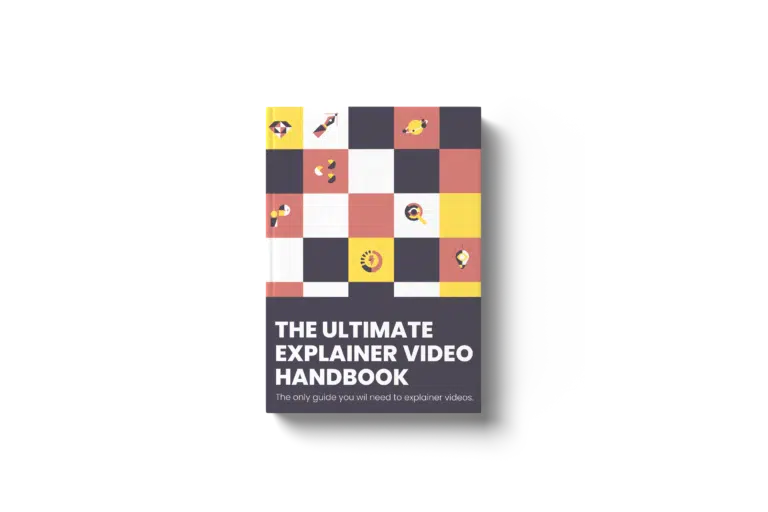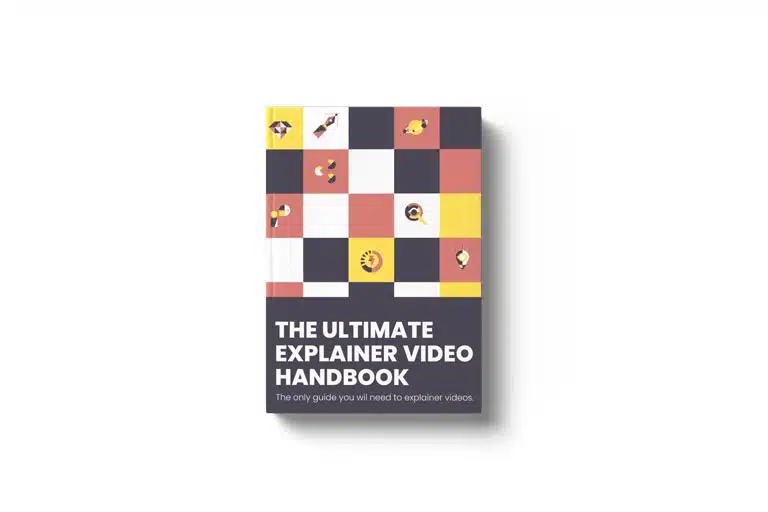Last Updated on February 4, 2025
Looking for a comprehensive guide to explainer videos? Look no further! After working for more than thirteen years and creating several successful explainer videos we have understood what it actually takes to create high-quality videos with little effort. And we have capsulated all our learnings, starting from the very basic to inner know-how of the industry, into a single, easy-to-understand, document on explainer videos.
So whether you are a business/startup looking to create an explainer video or want to know more about how an explainer video company works, or you are a video creator trying to get a better understanding of the explainer video creation process, or you are someone simply curious about these explainers…worry not, we’ve got something for everyone!
Before we take you through the specifics of producing explainer videos, let us cover the basic definitions, terminology, and FAQs. So lights, camera, action!
Table of Contents
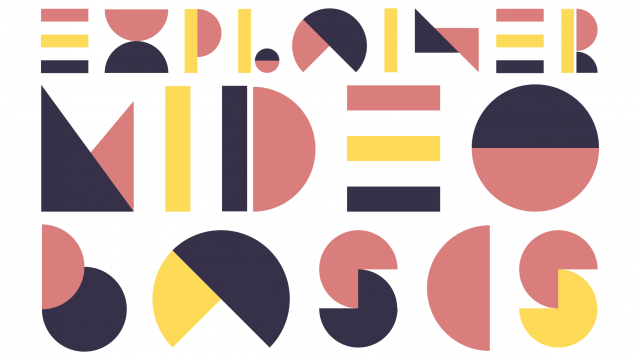
Explainer Video Basics
What is an explainer video?
An explainer video is a short video created to explain a tech or a product or a service. It is used to simplify and explain even a complex concept in a clear and concise manner. Most explainer videos are animated, although this is more of a norm than a rule.
The history of explainers, as we know them today, dates back to 2008, when a video production company called common craft created a video “Twitter in plain English” (more on this later). Back then it was also called product demo videos.
It was initially used to convert website traffic and convince investors. It was the tech startups who adapted it first and most of them had it on their home page.
Now, it doesn’t matter if you sell a product or a service, an explainer video has become a must for every business owner.
NOTE: Explainer videos are often called “explainers”. And while they typically just “explain” something, they can often include testimonials, training material and promotional videos too.
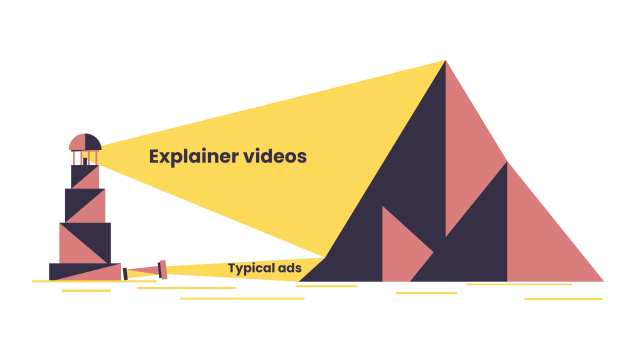
Why are Explainer videos different from typical advertisements?
While the purpose of ads and explainers is the same i.e. bringing awareness about the product or service, promoting it, increasing sales, etc, they both do not approach it in the same manner. Typically, explainers delve deeper into an explanation of the features and benefits of the product or service and do not sell directly the way commercials do.
Why do you need Explainer videos?
An explainer video is like a sales agent sitting on your website selling your work 24×7 and 365 days. It is a great tool to increase your conversions, improvise SEO, and spread your ideas on social media. There are a number of reasons for creating these videos. We will explain in detail the various applications in the coming chapters.
Explainer Video Production in a Nutshell
There could be many elements in a video creation process. But you can narrow it down to three key elements that will be present in creating any explainer video. These three key factors are very important to producing a unique memorable video.
An easy way to understand these key components is to imagine a pizza – an Explainer video Pizza.
Layer 1: Dough – Intent (Why do you need to do this video?)
Layer 2: Cheese – Content ( What do you need to communicate in the video?)
Layer 3: Toppings – Style ( How do you want to communicate?)
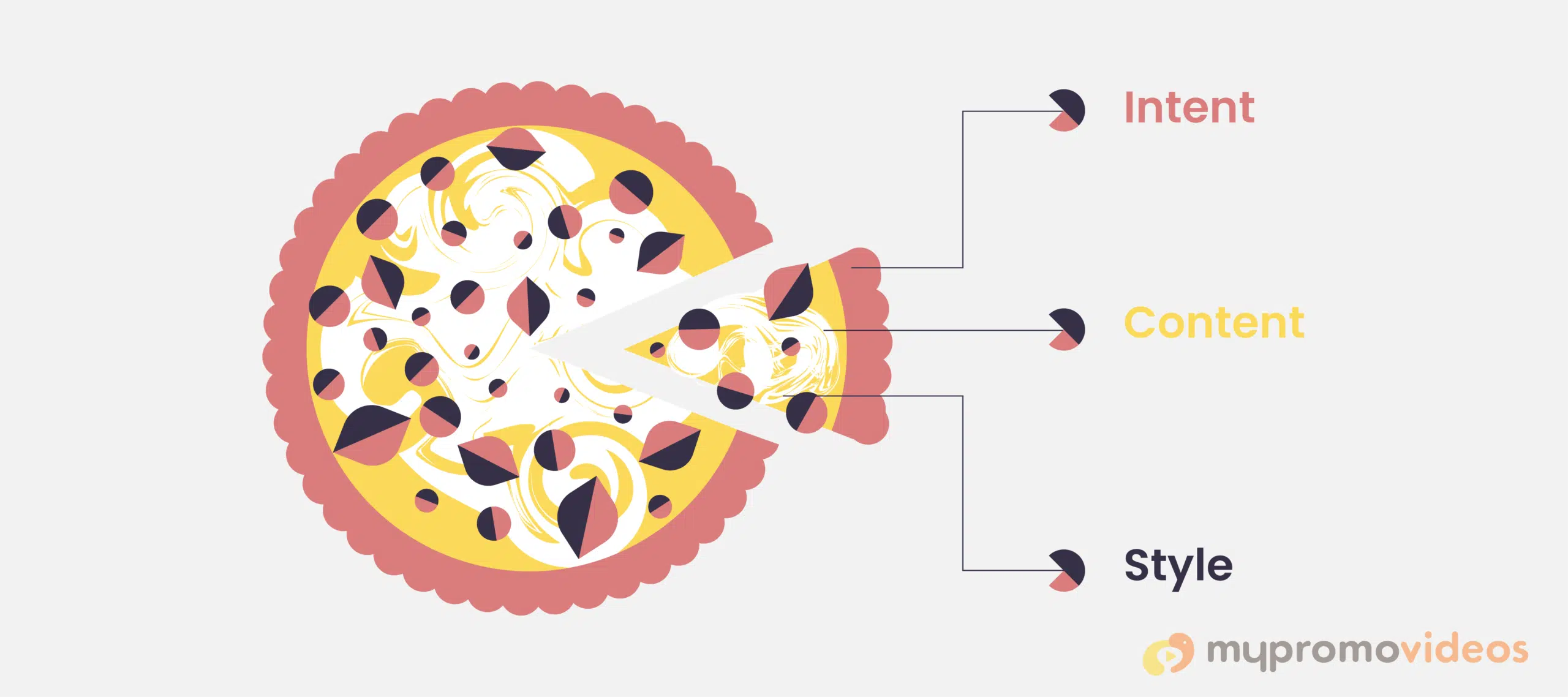
Intent:
The dough represents the intent. As a maker, you need to clearly define the purpose or the outcome you need out of the video. Once you crack this, it becomes easy for you to make a lot of creative decisions down the line.
Content:
The cheese represents the content. Without proper messaging, your video will be useless. This is the most important factor of the video.
Style:
The toppings represent the style. From classic onions to double-loaded toppings there will be various options on the menu from which you can choose. The quality in which the style is produced defines the authority of the video, which in turn determines your brand expertise.
In the following chapters, let us look into all the aspects of explainer video creation.
If you are looking to create a captivating explainer video, consider collaborating with a reputed explainer video company in Bangalore.
Different Types of Explainer Videos:
In the second chapter of this explainer video guide, we will help you understand the various types of videos based on both the intent and the style.
Explainer videos are a staple in the portfolio of any skilled promotional video production company, showcasing creativity and clarity
Based on Intent & Content
Based on the Intent & Content the types of explainer videos can be:
- Product explainer videos
- Demo Videos
- Promo Videos
- Corporate Videos
- Educational Videos
- Training Videos
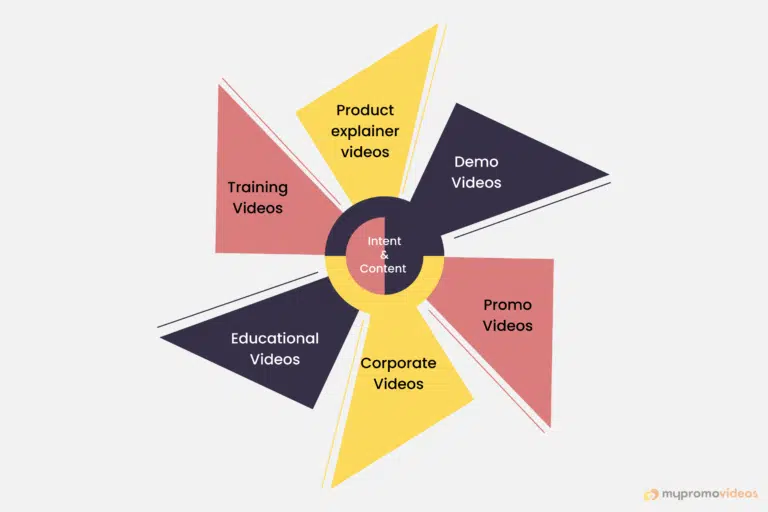
Product explainer videos:
What are Product Explainer Videos?
Product Explainer Videos are short videos showcasing your product and its user benefits.
A good product video helps your customer to get the idea behind the product and explains what problem it solves for them along with its features and benefits. A product video is typically short(60-90 seconds) and uses storytelling techniques to connect with the user, usually using motion graphics animation. It is used for marketing the product.
Why make Product Explainer Videos?
Product Explainer videos highlight the innovative idea that resulted in the creation of the product. They get the viewers excited about the new product with a desire to experience it.
Some Advantages of Product Explainer Videos:
- Easily explain your product
- Attractive
- Connect to emotions
- Tell a story
- Short
- Shareable
- Improve Brand Value
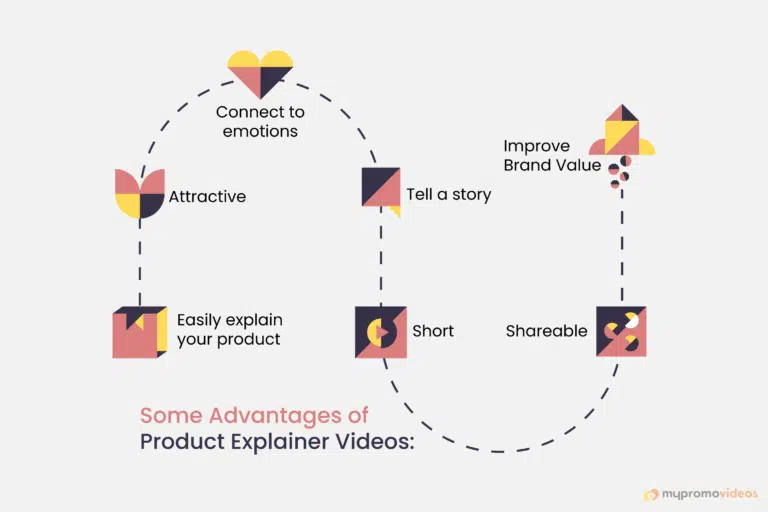
Demo videos
What are Demo Videos?
Demo video is short for demonstration video. Demo videos are videos created to show your product or service in action. They show exactly how your product/ service works.
Demo videos communicate directly with the end user by demonstrating exactly what they will be getting, hence they can be a very persuasive tool. If you have to show how your interface looks, for example, they can do so with the demo video. The demo video will also take them through each feature and explain all the tools of your product/service making it easy for a new user to use your product/service.
Why make Demo Videos?
As the name indicates, a demo video (or a demonstration video) demonstrates what your product does. It is like a video guide to your product or service.
Software these days often have nifty features and tools that can be brought to the notice of the user with such a video. If used before sales, it can convince your customers to buy, after-sales, it can help your customers to navigate and use your product to its full potential.
Some Advantages of Demo Videos:
What are Demo Videos?
- Showcase the product
- Highlight all the features easily
- Prove your worth to potential customers
- Sell without selling
- Gain loyal customers
- Solve problems before they arise
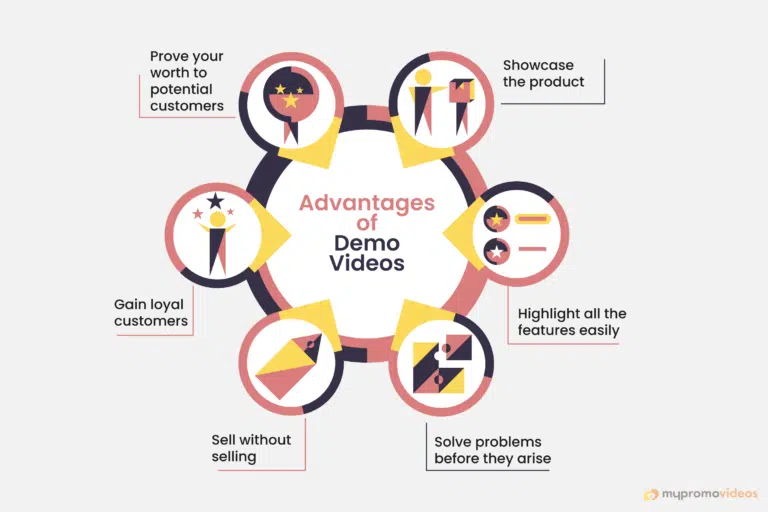
Promo Videos
What are Promo Videos?
When you create a video or a short film with the aim of promoting your brand, product, or service, you are essentially creating a Promo Video or a Promotional Video. Yes, these videos help you with your sales and marketing efforts directly.
They are usually used in events or used as commercials.
Why make Promo Videos?
Promo videos only speak about the positives of your brand. As they are audio-visual, and more often than not, entertaining, they are memorable. Hence they leave a lasting impression on the viewers resulting in sales eventually.
Some Advantages of promo Videos:
- Grab attention
- Engage viewers
- Influence decision making
- Improve conversion
- Sharable
- Showcase the best benefits
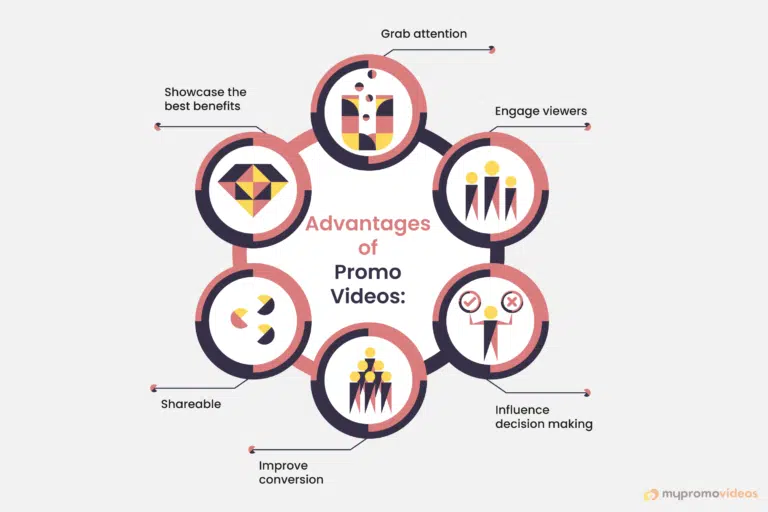
Corporate Videos
What are Corporate Videos?
Videos produced by organizations or corporations for brand-building, brand education, or brand awareness. Usually, such videos are longer than other explainer videos, have a distinctly formal tone, and establish the company as a leader or a champion in the minds of the viewer.
A corporate video can include topics like the company’s journey from rags to riches, its thriving multicultural employee atmosphere, its CSR activities, etc.
Why make Corporate Videos?
With their unique tone, sense of authority, and professionalism, Corporate videos help your organization stand out. They exude confidence and establish you as experts in your domain.
Some Advantages of Corporate Videos:
- Work towards brand building
- Establish authority
- Help brand reinforcement
- Gain brand loyalty
- Be perceived as a leader
- Tell brand story
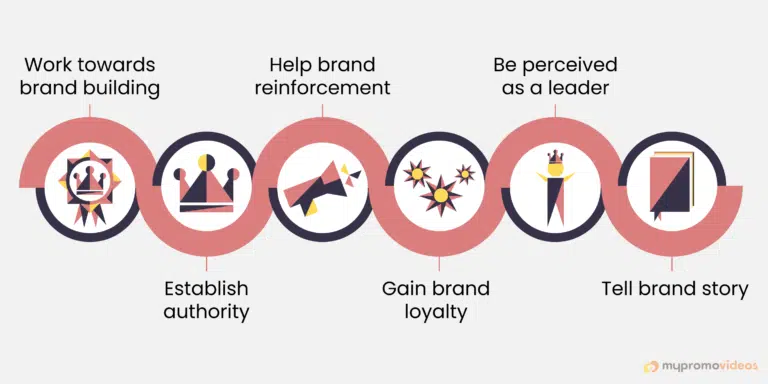
Educational Videos
What are Educational Videos?
As is evident from its name, Educational Videos educate the viewer about a particular topic. These may or may not be academic in nature. While educational videos could be created by schools, universities, and other academic institutions to educate students their meaning is not limited to this.
Educational videos are these days created by business organizations, YouTubers, and others to engage customers and increase viewership.
Why make Educational Videos?
Educational videos share the knowledge you have with your customers. They could be tips and tricks you picked up along the way or they could be nifty little ways to use your product. With educational videos, you could encourage your viewers to use your product more or invest in add-ons or upgrades.
Educational videos also help your customers use your product the way you intended it to be used. Apart from this, it helps a brand position itself as an expert in the field. For example, this blog has educational content. You can position yourself as an expert only by sharing your expertise.
Some Advantages of Educational Videos:
- Increase customer awareness
- Gain customer loyalty and trust
- Customer engagement
- Shareable
- Useful in SEO
- Upsell and cross-sell
If you are looking for an explainer video company in Mumbai, they can assist you in creating high-quality educational videos that enhance customer engagement and reinforce your brand’s position as an expert in the field.
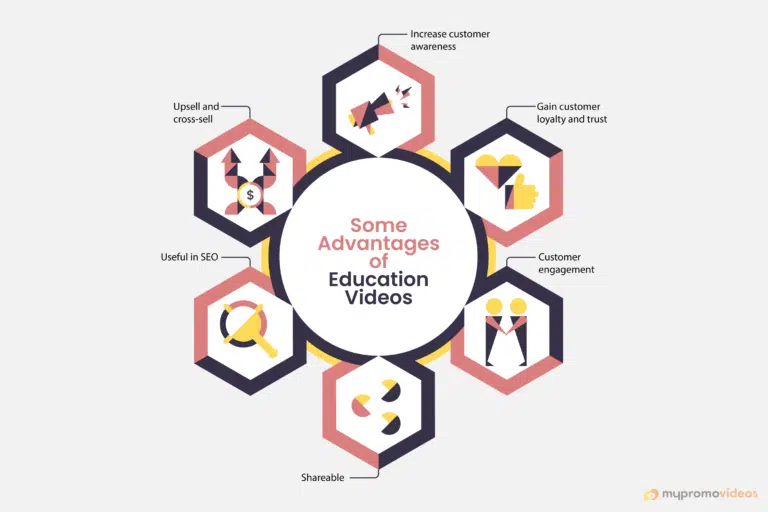
Training Videos
What are Training Videos?
Training Videos or Employee Training Videos are created to easily impart training-related information to the employees without overwhelming them. By opting for these videos the message is kept consistent and engaging. A variety of formats could be used to put your point across.
Why make Training Videos?
Training employees is part of any organization’s responsibilities. This is a task that needs to be repeated time and again. Sometimes you have the time for it, sometimes you don’t. And even when you do, making sure that they are attentive throughout is a challenge.
Creating Training Videos helps to ensure you give the proper training each time without compromising on quality or employee engagement. You could use Training Videos for a variety of purposes like employee orientation, compliance training, safety training, skill development, etc.
Some Advantages of Training Videos:
- Aids skill development
- Makes training engaging
- Provide consistent training quality
- Maintain training quality across your branches
- Useful for internal branding
How to choose the right type of explainer video? How do you get clarity on intention?
Here is a list of questions you can ask yourself to narrow down to the right explainer video for you. Before you start, ask yourself:
- Where will I be using it?
- Who is my target audience?
- How long do I want it to be?
- What tone do I want to strike through it?
or do you have questions for us?
Based on Style
Based on the Style the types of explainer videos can be:
- 2D Animation
- 3D Animation
- Hybrid
- Whiteboard Animation
- Kinetic Typography
- Stop Motion
- Live-action
2D Animation Explainer Video
What are 2D Animation Explainer Videos?
2D Animation Explainer Videos are the most used style of explainer videos. They are easy to produce and easy on the eye. “2D” stands for animation art which is created in 2-dimensional space.
As it is quicker and often more cost-effective it is an extremely popular choice for creating all types of explainer videos. 2D Animation Explainer Videos could be character-based or use motion graphics, or a combination of both.
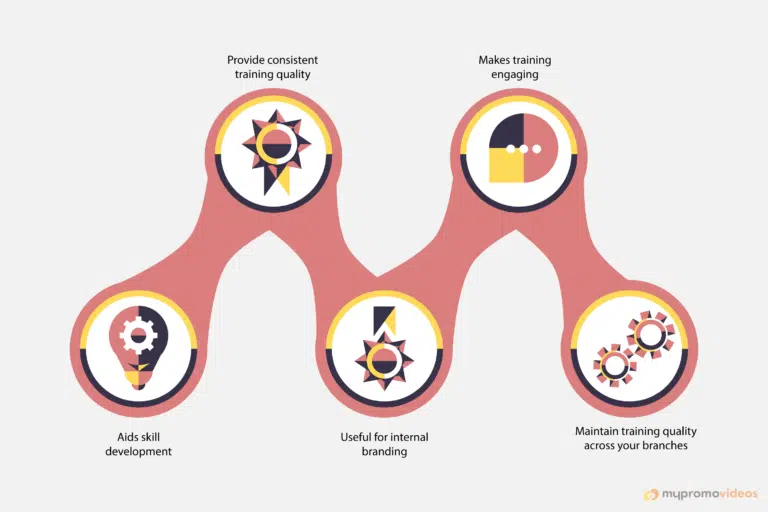
Why make 2D Animation Explainer Videos?
2D Animation is versatile and can be used to fit a variety of purposes including social media, websites, apps, and other marketing and advertising platforms.
They can be made to look cute, cartoonish, casual, or professional. They can usually be produced in a shorter amount of time when compared to 3D or high-production live shoot videos and can look as good in quality.
Some advantages of 2D Animation Explainer Videos:
- Faster production time
- Easier to edit
- Versatile
- Cost-effective
- Easily connects
- Simplifies your message
- Shareable
- Can be used on many platforms
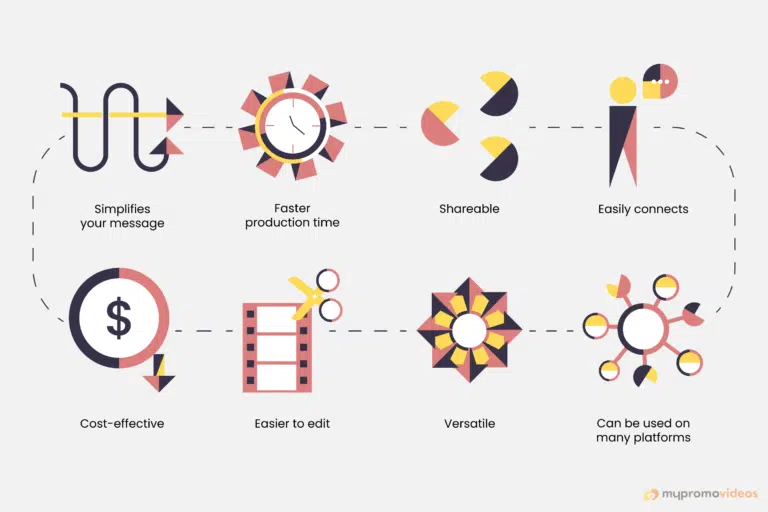
3D Animation Explainer Video
What are 3D Animation Explainer Videos?
3D Animation Explainer Videos, as the name suggests, are explainer videos created using 3-dimensional animation. As the objects are 3-dimensional, they can move around organically, just like real-life objects, and therein lies their appeal. They can be used to bring out details in a model and explore aspects in-depth.
Why make 3D Animation Explainer Videos?
There are several situations where 3D Animation Explainer Videos may be extremely beneficial. If you want to impress your audience with extraordinary visual effects, 3D animation will make it easier to achieve. If you want to show the intricate workings of a tool, then again 3D animation is the way to go.
They are instrumental if you want to create proof-of-concept or build a model to convince potential investors. As they move in 3 dimensions they have a very real feel and hence bring the best of both worlds- real-life feel with animation.
Some advantages of 3D Animation Explainer Videos:
- Fancy visual effects
- Good for details
- Impressive
- Imaginative
- Life-like
- High-end feel
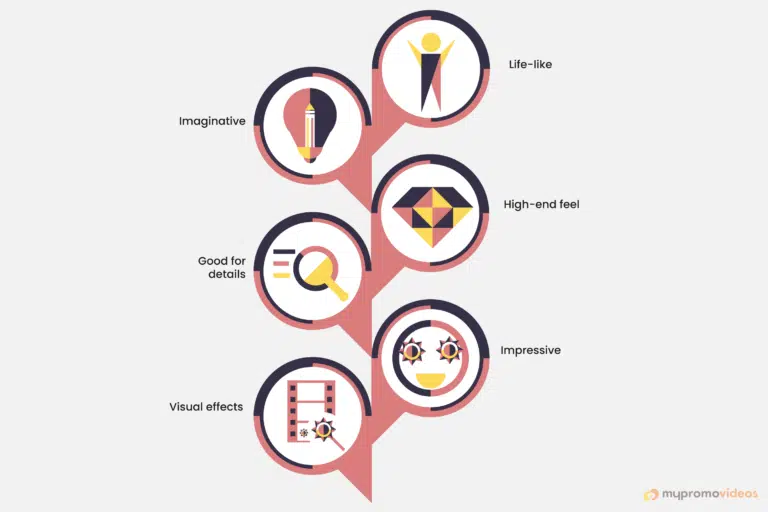
Hybrid Animation Explainer Video
What are Hybrid Animation Explainer Videos?
Hybrid Animation Explainer Videos bring the best of both worlds- 2D and 3D animation. By combining the two one is able to combine the simplicity of 2D animation with the attention to detail that comes with 3D. So depending on the scene or frame, the animation style can change, thus giving the creators more flexibility when it comes to execution.
Why make Hybrid Animation Explainer Videos?
Hybrid Animation Explainer Videos are useful when you have budget constraints or want to save time. Sometimes you want the videos to have a simple tool and feel, but you want the objects to move in 3D space, in such a situation too, a 2D-3D Hybrid could be opted for. They can be also used to achieve aesthetically unique results.
Note: In some cases, the footage is added to Hybrid videos, these are also called mixed media videos.
Some advantages of Hybrid Animation Explainer Videos:
- Best of 2D and 3D
- Cheaper than 3D
- Saves time
- More detailed than 2D
- Unique end result
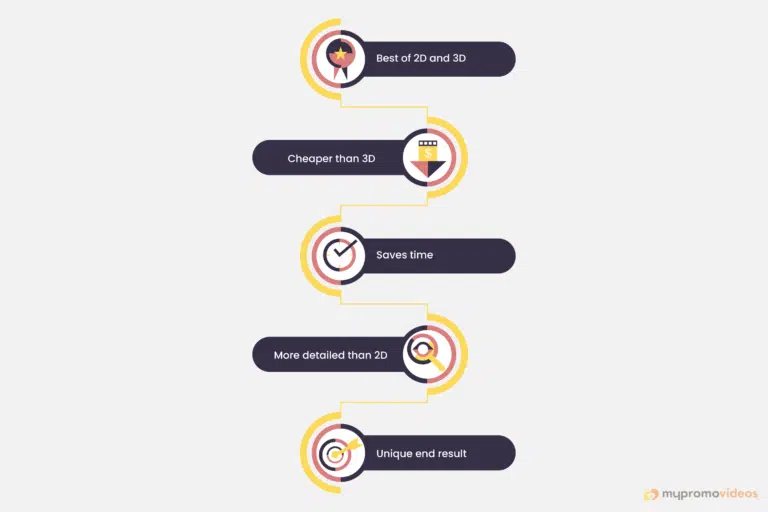
Whiteboard Animation Explainer Video
What are Whiteboard Animation Explainer Videos?
Whiteboard Animation Explainer Video typically looks like black drawings being drawn on a whiteboard with a hand, thus giving them the name “whiteboard animation”. The artwork is usually simplistic, often like doodles, and woven in with the narrative. In fact, it is safe to say that in such videos the narration or the voice-over is the king. Even the text on the screen is kept to a minimum. We could see early forms of Whiteboard Animation popularized by Common Craft, whom we mentioned before. Common Craft started by using cutouts and stop motion animation on whiteboards. Another style was popularized by RSA Animates around a decade back too, and that seems to be the style that became the forerunner of the current trend.
Why make Whiteboard Animation Explainer Videos?
To the point and simple, Whiteboard Animation Explainer Videos are an excellent choice if you want to emphasize the content of the narration. They work very well if you have a complex topic to explain.
Some advantages of Whiteboard Animation Explainer Videos:
- Faster production time
- Easy to execute
- Memorable
- Simple
- Good for elaborate explanations
- Replaces powerpoints and slides

Kinetic Typography Explainer Video
What are Kinetic Typography Explainer Videos?
Animation Explainer Videos created using only moving text are called Kinetic Typography Explainer Videos. Usually, the text is animated to synchronize with music or the voiceover. It can have other elements like characters or graphics added to the video to complement the text but text is the dominant part of the video. The script and music play a crucial role in the success of this video. Although the script can be simple, it needs a special kind of expertise to make the text attractive enough for animation.
Why make Kinetic Typography Explainer Videos?
Kinetic Typography Explainer Videos work very well if your message is short and uncomplicated. A very long typography video could get a tad tiring but a short one can be extremely effective. The production process of a typography video is not complicated unless you are trying out something totally groundbreaking. It can be used at events and summits where you can’t have audio but need to convey the message through visuals.
Some advantages of Kinetic Typography Explainer Videos:
- Good for short messages
- Straightforward and direct
- Production process uncomplicated
- Can be combined with other types
- Good for summits etc
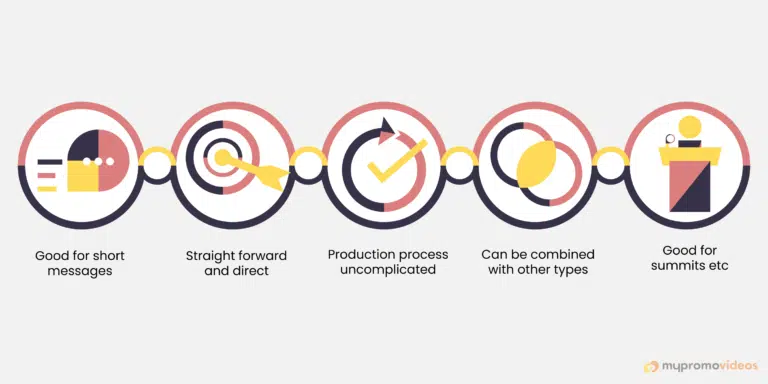
Stopmotion Explainer Video
What are Stopmotion Explainer Videos?
Stopmotion Explainer Videos are explainers created using the stop-motion technique of moving objects incrementally in each frame and taking photographs of these objects. Such a technique makes it look as if the objects are in motion- using more than a dozen photographs for a single second of video. Naturally, the process is quite lengthy and requires more than a little patience. So why should one put in this kind of effort? Because they are Stopmotion Explainer Videos are impossible to replicate, they are creative and are great for brand recall.
Why make Stopmotion Explainer Videos?
Stopmotion Explainer Videos don’t need a lot of fancy equipment, although these days there are stop-motion videos being created on a high-end budget using high-quality equipment. But what they are high on is creativity. You can use a variety of objects from clay and craft materials to recyclable stuff to soil and grass to whatever catches your fancy and make the video come to life. Because of this, a Stopmotion Explainer Video has excellent recall value, people remember your brand.
Some advantages of Stopmotion Explainer Videos:
- Unique
- Creative
- Brand recall
- Shareability
- Flexible budget
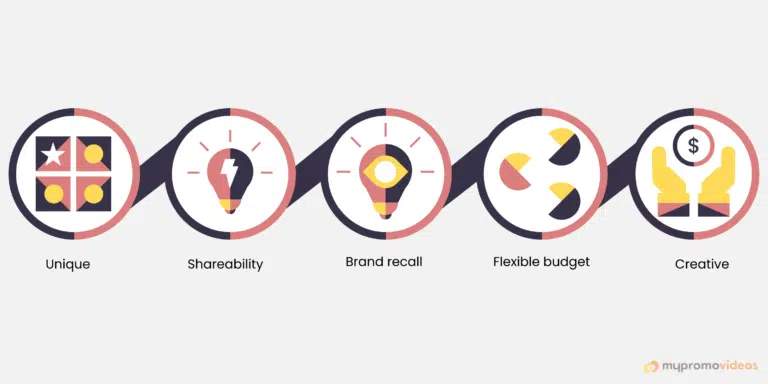
Live-action Explainer Video
What are Live-action Explainer Videos?
Live-action Explainer Videos have gained momentum in recent years. These explainers use real video footage instead of animation found in most of the above-mentioned categories. Of course, animated text and graphics could be added to the live-action videos to make them pop out. The video could use stock footage or shoot with real actors in locations, specifically for the brand. Depending on which option you choose the cost can vary tremendously.
Why make Live-action Explainer Videos?
Although there are many arguments to support Live-action Explainer Videos, most of these are subjective. If your target audience belongs to an older or highly professional demographic, you may try out this option. Or if you have a product or a service that can touch your audience only by showing real-life usage then again this style may come in useful. Needless to say, if you want to use brand ambassadors or client testimonials, then going for a Live-action Explainer Video is the best option hands-down, nothing can beat its authenticity.
Some advantages of Live-action Explainer Videos:
- Ideal if your product needs live demonstrations
- Great for showcasing testimonials
- Ideal option when working with brand ambassadors
- Can use animation for extra oomph
- Good for older or very highly professional audience
Looking for an experienced explainer video company in Delhi to produce high-quality videos in any of the styles mentioned above, check this!
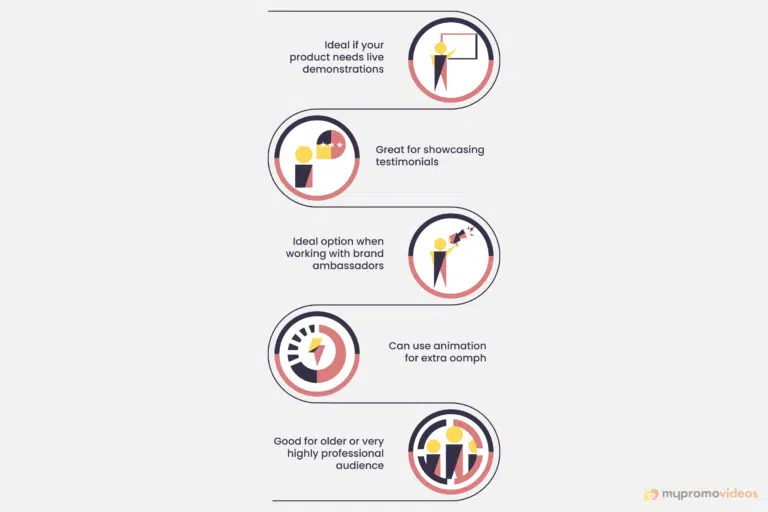
TIP:
Animated Explainer Video Vs Live-Action Explainer Video: Which is better?
There have been endless debates on this topic and quite frankly, the answer rests with what types of lenses you view the world with. Both styles can be costly, time-consuming, and ineffective for some audiences. Both styles can be budget-friendly, quick to execute and appeal to a wide range of audiences.
In the end, it all depends on the choice you make and the video production partner you go with. Look at the strengths and weaknesses of your production company and then decide, or trust them to come up with an option that could best deliver the message you want. Alternatively, you could choose a style and then select a production company that matches your preferences. Actually the same goes for choosing any of the above-mentioned styles of video too.
What makes Explainer videos so effective?
We know how to make an explainer video that are becoming popular and nowadays customers expect your websites to carry explainer videos too. But why? Why are they so effective? Why are both the consumer and the marketer singing praises of this format of selling? Let’s dig into it a bit deeper.
Easy for the marketer and the consumer:

Explainer videos make the job of “explaining” easy. They combine audio and visual inputs thus needing less effort from the marketer when it comes to conveying what they would like to. Where they may have needed hundreds of descriptive words, just a simple visual would now do! And Explainer videos make the task of consuming content easy too. Consumers are 27.4 times more likely to click through online video ads than standard banners and almost 12 times more than rich media ads. The reason for this seems obvious, right? It’s because videos are way more attractive than text. And the ease with which one can understand the message in the video can play a major role in this attraction.
Short in duration, long in the recall

Appeals to one and all

Does this mean that you don’t have any set target audience for Explainer videos? No, not actually. But rather, Explainer videos can be created to cater to any kind of audience. Explainer videos are not limited to just a particular type of audience. Young or old, professionals or students, artists or scientists, urban or rural, Explainer videos can be created to attract any kind of demographic.
Brand Positioning and Positive Impact
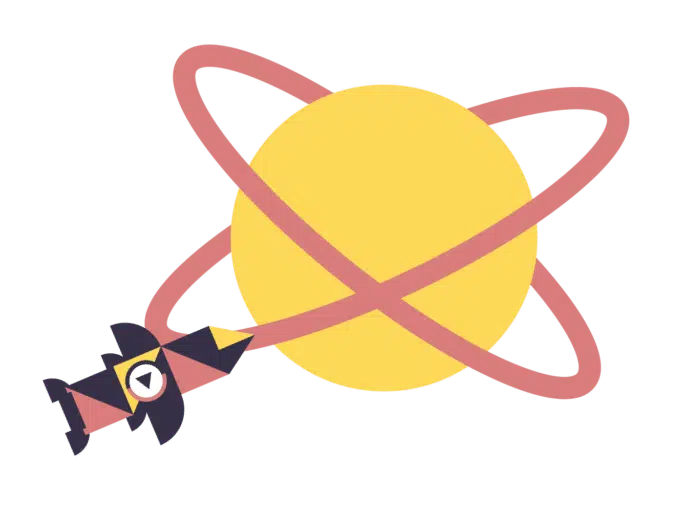
A good explainer video doubles up as a brand ambassador for your product or service. It advertises while explaining and impresses while entertaining. Videos are everywhere today and a good explainer stands a decent chance of getting shared. We know that videos touch people personally because they appeal to more senses and as explainers are people-friendly, they especially touch a chord. If you combine all of this with a video that is designed and executed well, you are giving your audience a treat to remember. Hence they are an effective means to build your brand.
Reach consumers wherever they are

Great at converting

Useful Vocabulary
Treatment

Treatment concerns the aspect ratio of the video. Should the video be in Landscape mode or Portrait mode? This means making the choice of whether the video should be horizontal or vertical. Usually, horizontal videos are preferred but vertical videos are becoming the trend these days.
Creative Scope

Creative scope is also referred to as project scope. It is arrived at by envisioning how you know the final product to be, and the creative approach you will take. It will help you define the budget and the time frame for the explainer video too.
CTA

CTA stands for the call to action. It is usually a marketing statement that triggers action spoken or written (mostly) at the end of the video. It has to be short and direct.
Assets

The assets of a video are all the objects you can see in the frame. All the items that are created for the video with a computer, like the shapes, the buildings, the chairs, the characters- anything and everything the scene contains- are considered an “asset”.
VFX

VFX is short for Visual Effects. These are images that are used to enhance or add to a scene, usually used on a live-action video.
SFX

Depending on the context, SFX could stand for Special effects or Sound effects.
Aspect Ratio

The aspect ratio is the ratio between the width and height of an image. It determines how much gets covered on the screen and how we will perceive the objects. This comes in handy when you are deciding whether you are doing a portrait video or landscape video.
VFX

VFX is short for Visual Effects. These are images that are used to enhance or add to a scene, usually used on a live-action video.
If you are looking for a reliable partner to create high-impact visual content, an explainer video company in Chennai can help you harness the full potential of this powerful marketing tool.
Frequently Asked Questions
There are a number of tools that can be used to create explainer videos. And it is understandable that you want to create explainer videos. It has some pros:
- It can be cheaper
- There is less to-and-fro
- Nobody understands your brand as you do
But unfortunately, there are some very cons, and these are the reasons why most companies do not opt for it.
Assuring quality can be a risk:
As you are not a professional, getting the same quality standards as a production company can be challenging, if not impossible. Nuances of writing a script that’s short and engaging, animating or drawing characters to evoke the right emotions, adding sound effects that draw the audience in, etc., are best left to experts who know exactly how to get it done.
Compromise on Brand Image:
When the quality is compromised, the brand image is compromised. People will not choose your product or service with confidence. How will they be able to trust a company that could not even take the effort to make a high-quality explainer to explain things to them?
You may actually end up taking more time:
Because this isn’t your area of expertise, trying to create a video on your own may actually cost you more time in the long run.
It may end up costing you more money:
By compromising on all these fronts, you may lose your customers thus it may cost you way more than you had bargained for. What’s worse is that once a negative impression is created, it becomes difficult to remove it from the memory of the consumers. Are you sure you want to take this risk?
The cost of an explainer video depends on a number of factors including the studio, the quality of production required, the region where it is produced, and of course, the duration. These days you can make a DIY video for hardly any budget, you could use a freelancer from an outsourcing website and can still get one in say 600 USD. But these may not be ideal options. A good studio would generally charge you 3000 – 6500 USD is generally an acceptable range for a minute-long video. But then again, there are times when it can go up to 35000 USD, so it is all relative.
The charm of an Explainer video is in its length. So ideally, explainer videos should be short, not more than 60-90 seconds. If you have a lot of content you may consider going up to 2 and a half minutes, but anything longer than that may go beyond the scope of an explainer.
Explainer video formats
MP4
This format usually works well for all social media platforms. It is also the most common type of format. Some of the other formats can offer a higher definition quality than MP4.
MOV
They are also widely used in social media. These are Quick Time files that store high-quality videos and audio files. A drawback with MOV format is that files can be pretty large.
WMV
Similar to MOV, Windows Media Viewer or WMV are high-definition large files. A big disadvantage to using WMV is that you can’t select the aspect ratio.
AVI
Audio Video Interleave or AVI works on most devices including TV, most browsers, and streaming platforms.
Flash(FLV, F4V, and SWF)
Built for Flash Player, this can be used to stream Youtube but has the major disadvantage that apple devices aren’t compatible with it.
MKV
This is the favorite of open-source media players like VLC or Miro.
WEBM or HTML5
As these are small and laid easily, they are a great choice for a website video.
MPEG-2
This is your choice if you want o to burn a DVD with your video.
TIP:
How to choose the right format for your explainer video?
Ask yourself “Who will be watching this video? Where will they watch it? Do I plan to use it in any other way?” If you need further clarity, try talking with your video production partners, they may be able to guide you.
Process of creating an explainer video
Research

From the client’s perspective research is the first step to creating an explainer video.
What should you ask yourself before you create your video?
- Why am I creating this?
- Who is my target audience?
- What is the message I want to convey?
- Will I go with a production studio or try to make the video myself?
What is the process of creating an
explainer video?
Creative Brief

It begins with the Creative Brief from the client to video production partners. Usually, every studio has its own creative brief format. These are basic “getting to know you and your product” questions. It sets the expectation for things like:
- Message to be conveyed
- Target audience
- Tone and treatment preferred
- Competitors and USP
A detailed creative brief helps reduce confusion and facilitates better brainstorming.
Brainstorming

On receiving the brief, the creative team or some members of the production crew come together to brainstorm. This could be considered the most crucial step in the creative process. The team arrives at a concept, a rough idea for treatment, and the way the script will flow during the brainstorming session. After which it is time for the next step.
Script

The script decides not only the words that will be spoken in the video but also sets the tone for the explainer. Is it going to be formal or quirky? Will you go for a conversational tone or a corporate one? It all depends on the script. A well-crafted script can reel in all the important points needed to engage the audience, explain your product, and still add value and substance to the animation. Sometimes there may not be a voiceover in the video, as in the case of typographic animation, but it still needs a script with the text of the words that will be appearing on the screen.
Qualities of a good Explainer video script:
- It is short
- Does not beat around the bush
- Covers the marketing message
- It is engaging
- Grabs attention in the first few seconds
- Has a neat closing
- Does not repeat points unintentionally
- Does not talk down to the audience
- Uses language suitable for animation/action
- Uses language that the audience understands
Voice Over

Most often animation for a video is done over the voice-over, hence in the case of animated explainer videos, the voice-over is recorded way before the animation stage, usually before or along with the storyboarding stage. In the case of a live-action explainer, explainer video voice over can be recorded at a later stage too.
Qualities of a good voice over:
- Is consistent with the tone intended in the script
- Uses clear pronunciation
- The voice is pleasing
- Uses easy-to-understand accent
Storyboarding

A storyboard is the visual plan of the video on paper and looks something like a comic-book strip.
What does a storyboard consist of?
- A sketch that depicts the elements(characters, assets, and texts) that will be appearing in each shot of the video
- A detailed description of the shot and
- The text of the voiceover, if there is one.
Animatics

While some production houses do not have this step, some do. Animatics basically help in making the plan for the video flow, especially if the video is animated. It helps you set timing, and guides you about what needs to come when in each scene.
Illustration

Now we finally get to the stage where you start illustrating each scene. All the assets and characters are created. Some studios may also present their clients with a “Styleframe” at this stage.
Styleframe

Styleframe is an image that gives you the exact look and feel of the video. The color, the style, the treatment, etc., all get conveyed via the styleframe.
Animation

After the illustrations are ready it is time to animate. Usually, animators use voice overs to time their animation. If the video does not employ voiceover, music is used instead. Animation can be of different types, like 2D, 3D, motion graphics, typography, etc, as we have seen in the earlier chapters of this handbook.
Music and SFX

The final stage of the explainer video creation process is adding music and sound effects. There was a time when stock “explainer” music used to suffice. These days custom music is preferred. Music and sound effects have to be carefully planned to be subtle and interesting, they have to go hand-in-hand with the rest of the video without overwhelming the narrative.
Time Taken to create an explainer video
Most production studios are able to deliver a 60-90 second video of decent quality in 4-6 weeks.
Factors that affect the time taken in creating an explainer video:
- Duration of the video: A 15-second explainer will take less time to create than a one-minute video.
- Quality of the video: The better the quality needed, the more the time taken for video completion
- Experience: An experienced production partner may be in a better position to produce videos within a stipulated time frame. Resources: If you have advanced resources, like a good rendering computer and high-quality software, you can bring down the production time substantially.
- Manpower: Again, when more manpower is engaged in creating a video, usually the duration taken for completing the video gets reduced.
- Feedback time: If you are able to give prompt feedback at every stage then the time taken can be optimized.
- Quality of feedback: If there is a single point of contact, giving clear, concise feedback, and the feedback does not run into loops of revisions, then the time taken can drastically come down.
Finding a platform
Professional video production companies have a number of tools that they use for creating Explainer Videos including Adobe After Effects, Blender, Maya, Renderforest, Adobe Illustrator, etc. But these tools can prove pretty challenging if you are trying to create a video by yourself.
Here are some of the factors to consider when choosing a platform:
- Ease-of-use
- Cost
- Membership plans
- Availability of tutorials
- Flexibility
- Styles and templates offered
- Possible customization options
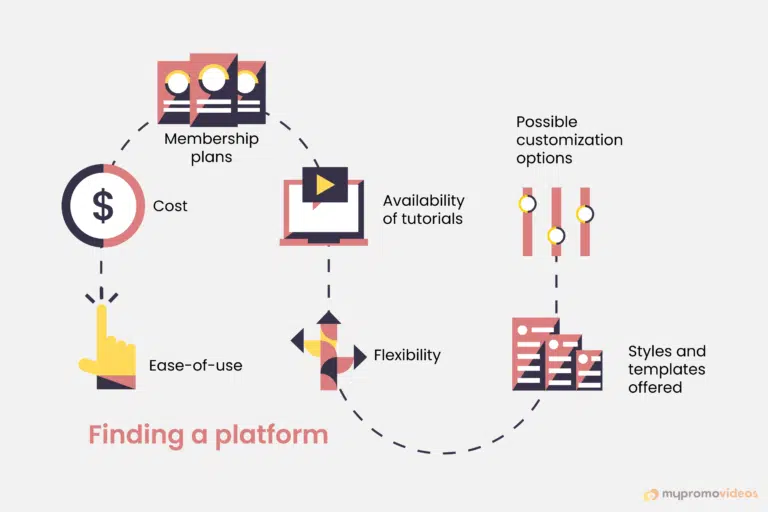
DIY Platforms for Creating Explainer Videos
We have already discussed the advantages and disadvantages of trying to create explainer videos by yourself. If you were to create them by yourself, what would be some of the platforms you could opt for? Let us take a look.
This is a very simple explainer video creation tool that is very popular. It offers you a variety of styles and templates to choose from. Powtoon videos can look a bit “unrefined” from a professional point of view.
Animaker helps you build customer character which is a very useful tool. The templates on offer on Animaker are a little limited, though.
Very similar to Powtoon, Vyon gives a similar range of customisation options. Videos created on Vyond can seem a tad “generic”.
Biteable a is a great tool if you want to bring flat background style into your videos. Biteable also offers music and soundtracks. But as you can only choose from existing templates, creating a cohesive and balanced explainer video becomes a challenge.
This is a drag-and-drop desktop tool with enough tutorials to help you create an explainer by yourself. Unfortunately, the style offering is limited.
Finding the studio
A production studio may be better positioned to create an explainer video that maintains your brand image and conveys your message succinctly. But what should you look for in a studio? Let us find out.
Best explainer video software you need
Portfolio
The first thing to do would be to look at their portfolio, this will tell you about what type of videos they make, the quality standards they can meet, and if overall they can gel with what you want from an explainer. It is possible that what you want is something entirely unique, but still, the portfolio helps set the benchmark.
Experience
While experience does not always equal quality, it does speak of a certain amount of credibility. If a studio has a lot of experience, there is a good chance that they will be professional in their approach and may be able to deliver good quality on time.
Team
Looking at the team is similar to looking at the experience. It helps you gauge how good the resources are.
Testimonials and Previous Clients
Obviously, if they have worked in a Line of Business similar to yours, explaining your product becomes easier for them, so you need to know who they worked for. But you also understand the kind of impression the studio made by taking a look at the testimonials they received.
Turnaround time
How long does it take for the studio to create an explainer video? This becomes a very important factor to consider when shortlisting one.
Pricing
Even if you are a multi-million dollar company, you will want to know that you got the best deal, so you need to look at the pricing. But make sure that the quality is not compromised in the quest for cost-effectiveness.
Approachability
Some experts may ask you to go for a local studio because it would ensure better communication. But in today’s era of technology and work from home, such ideas are becoming obsolete. What is more important is to see how willing you are to cooperate with the production partners and if you can arrive at a time to communicate that works for all parties involved.
Now that we know what goes into creating your Explainer video, you are all set to get your own explainer. But wait! Your explainer needs to be optimized for where you plan to use it. How? That’s where our next chapter comes in.
Optimizing Explainer Video
(for different uses)
You have great web content, but no one comes to your sites, search engines don’t rank your pages and your content lies hidden? This might sound familiar to you in terms of SEO and written content. What you need to know is that we need the same kind of optimization for video content too. Otherwise, they will not be noticed on sites like Youtube or Google. Don’t worry, we will tell you how you can do it.
Optimizing your explainer video for Youtube
Video Title
To optimize your title, include your target keyword once in the title.
Description
Go for a longer video description, 250-350 words or more. Include your target keyword in the description.
Tags for the video
The Youtube algorithm keeps changing. While tags were once very important, they aren’t so anymore. However, there is no saying that they will not become important in the future. Hence make sure to include at least 5-10 well-thought-out tags, that are related to your explainer video and target keyword.
Other tips
- Use the Target keyword at least a few times in your video because youtube looks at the transcripts too
- Upload transcript in order to avoid misunderstanding
- Don’t use clickbait titles because if you can’t retain your audience, this may backfire.
- Use professional thumbnails
- Make sure your descriptions are good
Optimizing your explainer video for the website
Most people are drawn to the video on a website. If your explainer video on the website is optimized to give them a good user experience, they will stay on the site longer, interact with it, and have a better understanding of your product or service. Hence prioritizing the user experience becomes of utmost importance when it comes to explainer videos. Here are a few things you can do:
Optimize for Internet quality
Ensure that the video can be played regardless of the quality of the connection. Offer the user with lower-speed internet access the option to view the video at a lower quality.
Avoid Autoplay
Give the audience the option if they want to see the video or not, again, be mindful of the audience that does not have a good internet connection or those who don’t have the time to sit through a video.
Avoid pop-up videos
Do not use your explainer as a pop-up video, it can be tiresome to those visiting your site.
Make it mobile friendly
As stated elsewhere, your explainer video needs to be playable regardless of the device. Make sure that just like your webpage content, your video content gets resized for mobile devices.
Optimizing your explainer video for WhatsApp
Not all video formats are acceptable on WhatsApp. You also need to keep in mind that the video may not be just played on the WhatsApp phone but could also be played on WhatsApp for web. So play our video on all types of smartphones, tablets, laptops, and desktops before you decide to send it.
Video formats
Acceptable video formats for WhatsApp include MP4, AVI, MKV, MOV, FLV, 3GP, H264, or MPEG4 video codec and AAC or AC3 audio codec.
Video size
WhatsApp allows video files of only 16MB. If you want to send a larger video, then the best option would be to compress it.
Okay, so great! We have our video, and we have optimized it, shall we now see how to distribute it? Coming up in the next chapter!
Distributing Explainer Videos
Your explainer video needs to reach the right set of eyes. For this, it has to meet your audience at every possible touchpoint. You may have to exploit unpaid and paid avenues to ensure that you reach your target customer.
Unpaid Channels
Emails
Sending your explainers to your existing subscribers and contacts is the best place to begin. Make sure your subject line is interesting and does not feel like spam.
Social Media
LinkedIn, Facebook, Twitter, Instagram, YouTube, Snapchat, etc are just a few of the social media platforms that you can use to spread your video. Videos find a natural home on most social media sites and if they are shareable, a good explainer could garner a decent following.
Blogs
Blogs can be used in multiple ways. You can add your videos to your own blog posts, or you can send them to other bloggers to see if they would be interested in sharing them and if the content is relevant to them. If the explainer is highly creative, it can be picked up by creative sites too. You can also write as a guest blogger and subject matter expert on other sites and plugin your explainer.
Other Methods
Public relations, social forums, discussion boards, etc are other avenues you can explore for promoting your explainer without investing money.
Paid Channels
Online Advertisement
You can advertise the explainer on any of the social media platforms, or promote it with AdWords or AdSense.
Influencers
Tieing up with social media influencers to promote your explainer is another possibility.
Content Promotion
Just like advertising, you can use social media platforms for content promotion.
Curious about how all this promotion will help you? Well, boosting your SEO is the most important benefit that you can derive out of Explainer, let us see how that works in the next chapter.
Why Explainers are Great for SEO
Time and again you are told that Explainers are great for SEO, but exactly how? There are many ways by which you can improve the SEO of your websites but adding videos might just as well be one of the easiest. So let us delve into this topic, shall we?
Optimization that search engines love
Search Engines like Google often use videos as signals for good content. If your video has been optimized for Youtube, as we have covered in the chapter on optimization, it is good enough for Google also. Google too uses the same criteria- keywords, relevant description, etc. When search bots look for keywords they read through the transcription provided by you and use it to understand that you have content that can be ranked higher, thus your page gets ranked up.
Backlinks to boost your ranking
We have discussed earlier how Explainer can be shared on other platforms through paid and unpaid channels, when this happens, backlinks are created to the video that is on your website or channel. In turn, this brings up the ranking of your page, especially when you get high-quality backlinks.
Social Signals
When the videos are shared across social channels, Google understands it to mean that the content here is of value.
Retention rate magic
We optimized our Explainer with better thumbnails, titles, etc. Now comes the time to reap the benefits from it. It brings about better clickthrough rates and again, these rates as sure signals too search engines to pick up your content!
Hurray! Now you have done all that you could have done to ensure the success of your Explainer video. But how do you measure that it was actually a success? The next chapter has got you covered.
Analytics and Metric To
Measure Explainer Videos
You must have created your explainer video with some results in mind. So did you achieve it? You need the help of numbers to determine it. Here are tips to help manage the number game better.
View Counts
View counts help you understand whether the video was seen by enough viewers or not. But how the view count is calculated differs from website to website. While Youtube and Google do not consider it as a view if the videos had not been seen for at least 30 seconds, in Instagram and many other social platforms just 3 seconds of viewership is enough to count as a view. Youtube shorts have a different calculation too. So pay attention to where you are streaming your Explainer.
TIP:
How do you differentiate unique view counts from total view counts?
While unique view counts are how many individual new users are watching your videos, total view counts tell us the total number of viewers and may include repeat viewers.
Engagement
All viewers will not watch your videos to the end, and that’s a give, not even the best video on the planet can claim a 100% viewer engagement. But as a commercial explainer video, you need to know exactly how much of your video is being watched by the viewers and the parts that are most watched. Some platforms show you graphs and heat maps in this context, make sure to pay close attention to them.
Conversion
We optimized our Explainer with better thumbnails, titles, etc. Now comes the time to reap the benefits from it. It brings about better clickthrough rates and again, these rates as sure signals too search engines to pick up your content!
Hurray! Now you have done all that you could have done to ensure the success of your Explainer video. But how do you measure that it was actually a success? The next chapter has got you covered.
Explainer Video Best Practices
As you went through this handbook, we hope you got some valuable information about Explainer videos. You must have learned what to do and what not to do when it comes to creating explainer videos. Let us recollect them.
Goals
The purpose of the video comes first. Why is the explainer video being created? What is the message to be conveyed? What are the marketing benchmarks to be achieved via this explainer video? Ensuring that these points are clear is a top priority.
Target audience
Decide on the target audience. Try to be as specific as possible- their location, their job, age bracket- everything matters.
Execution
Some points to remember in the execution of the explainer video:
- Keep the message short and straightforward
- Explanation is the king, it should be out forth with as much clarity as possible.
- Make sure the video is creative but not distracting
- The voiceover should be clear
- Music and SFX should not dominate the explanation
Optimize
Your video may be awesome, but if it is not optimized, it may not reach the intended target. You have put in all the effort to create a great explainer video, make sure you do not miss out on this crucial step.
Analytics
Proactively look for the best channels to distribute your explainer videos. You need not feel hindered if using paid platforms does not fit your budget, there are several unpaid platforms you can choose from.
Distribution
Make numbers your friend, because they are going to tell you exactly how your Explainer videos are working. They will indicate if you need to optimize them further, and give you useful data when you create another video next.
Conclusion
Make sure that you implement all the pointers you have collected from this handbook and make a spectacular Explainer that works wonders for your business. We are an Explainer video creation company too, so need any help or assistance or need production partners? Please feel free to reach out to us!
or do you have questions for us?
